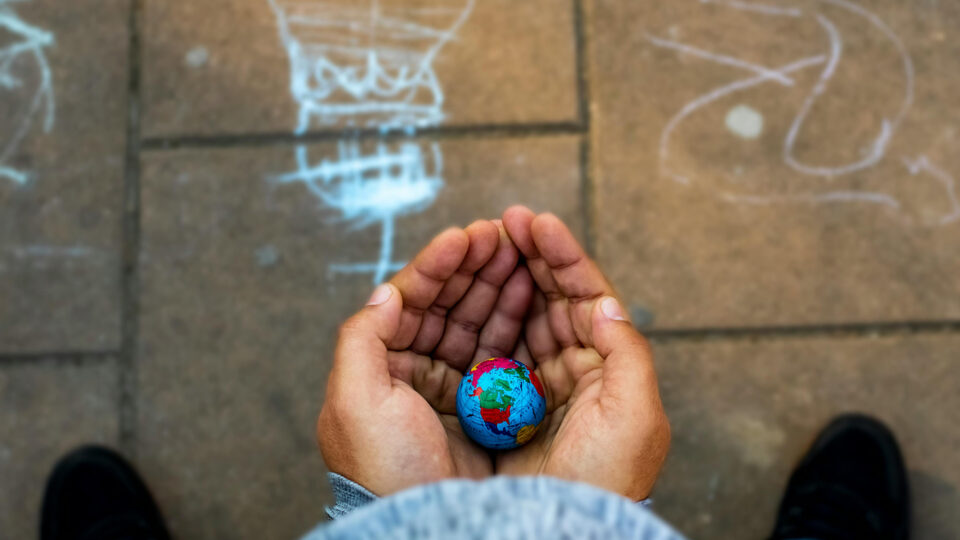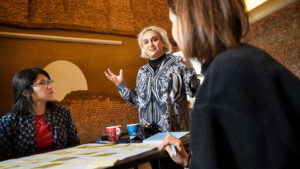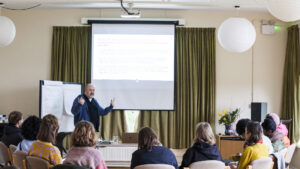- Posted on April 23rd, 2024
Disability, Care and Climate


Julie’s Bicycle Climate Justice Lead Farah Ahmed, reflects on the important intersections between climate, disability justice and care.
What is the link between disability and climate justice?
Disabled people are especially vulnerable to the impacts of climate change, in various different ways. They are four times more likely to be killed in a natural disaster and more likely to be left behind in evacuation efforts. Some medications make it harder to regulate body temperature – because of this, people with schizophrenia have a mortality rate fifty times higher than the general population in heatwaves. Zoonotic diseases like Covid are mass-disabling events, and similar pandemics are likely to increase as the planet warms and we encroach further into the natural world. 99% of the global population breathes polluted air, with low and middle-income countries more exposed. Across the Global North, People of Colour are more likely to live with toxic elements in our air and water, all of which leads to an increase in premature deaths, impacts lung development in children, and exposes us to more risk from strokes, lung and heart disease, and multiple other chronic disabling issues. According to the UN, 16% of disabilities are attributed to armed conflict, many of which are fuelled by the extraction and exploitation of land and resources.
At the same time, climate policy spaces are often inaccessible. At COP26 in Glasgow, a wheelchair-using minister was unable to access the negotiating areas. Policies like the UK’s plastic straw ban received pushback from many advocacy groups because they can be an important tool for disabled people. They are “systematically ignored”, and are rarely included in national plans to reduce carbon emissions or adapt to climate impacts.
But these amplified risks are not inherently because of disability itself. The Social Model of Disability says that people are disabled by barriers in society; the world is not designed for disabilities. Movements for Disability Justice show us that vulnerability to climate impacts is baked into an ableist system which positions us in a hierarchy of value, requires from us both hyper-productivity and hyper-consumption, and severs our kinship with the natural world and each other; hyper-capitalism is literally killing us.
“We are in a global system that is incompatible with life. There is no way to stop a single gear in motion — we must dismantle this machine.”
– Patty Bearne

What is Julie’s Bicycle’s response?
Our responses to the climate crisis have to include disability from the very start. As JB’s Climate Justice Lead I’m driven to move the conversation about climate justice in the arts and culture from words to actions. I am neurodiverse myself and know that this work has to be interconnected with other issues. We have to holistically redesign our society based on values of radical and generous love, interdependence, and genuine solidarity, bridging the intersections of disability, race, gender, age, sexuality, class, citizenship, and other marginalisations.
In the arts and culture it means designing our work programmes to make sure that disabled collaborators don’t burn out from physical, sensory and mental demands; consulting with disabled people about how we build our festival sets, theatre productions, or our conferences; and respecting the dignity, wholeness, expertise, and sometimes complex needs of disabled folks, especially when it doesn’t fit neatly into “the way things are done”. It means handing over space, platforms and resources to disabled people to lead the way. This is care in action.
We’re working on what this looks like for JB as an organisation focused on climate justice, and for anyone engaging with our events, resources, and training. We have made a good start in trying to make our work inclusive, but there is more to be done. We hope the No Climate Action Without Us toolkit will help other organisations who have not yet begun, to put in place some of the foundations for further work. Because alongside practical provisions, we have to ask deeper questions. Who do we invite to our spaces and how do we connect with disabled-led networks? How do we give our bodies and minds the space to breathe, grieve and heal through the physical, mental, and emotional impacts of climate change? How do we foster joyful, trusting communities across borders, species, and across different needs in person and in virtual spaces? How do we include this in our budgets? How do we share our resources? How could we communicate the climate crisis sensorily? What do care-centred futures look like – and what does care look like here and now?
“What our bodies require in order to thrive, is what the world requires.”
– Aurora Levins Morales
Doing this work benefits us all.

We’ve been involved in a partnership with Attitude is Everything and A Greener Future, on the No Climate Action Without Us toolkit, at how climate and accessibility initiatives at live music events and festivals can be more connected. You can read more and download the toolkit.
We are always interested in discussing new partnership ideas, and would love to hear from you about bold new ways that we could work together to advance disability-focused creative climate justice and climate action, get in touch.
“For years awaiting this apocalypse, I have worried that as sick and disabled people, we will be the ones abandoned when our cities flood. But I am dreaming the biggest disabled dream of my life – dreaming not just of a revolutionary movement in which we are not abandoned but a movement in which we lead the way. With all of our crazy, adaptive-deviced, loving kinship and commitment to each other, we will leave noone behind as we roll, limp, stim, sign, and move in a million ways towards cocreating the decolonial living future.
I am dreaming like my life depends on it. Because it does.”– Leah Lakshmi Piepzna-Samarasinha, Care Work: Dreaming Disability Justice
More resources
- Read Leah Lakshmi Piepzna-Samarasinha, Care Work: Dreaming Disability Justice.
- Read The Care Manifesto: The Politics of Interdependence by The Care Collective.
- Research from Creative Climate Leadership alum Alistair Gentry for Unlimited about disabled artists’ attitudes to sustainable artistic practice.
- Why disability is a climate justice issue.
- Principles of disability justice, Sins Invalid.
- Watch Nigerian disability activist Amina Rahma, from Rebuilding Hope on Wheels perform a poem “Echoes” at Julie’s Bicycle’s COP28 Resilience Hub event “How Creativity Can Build Resilient Communities”, December 2023. (poem from 59 minutes)
- Explore our Creative Climate Justice Hub.
